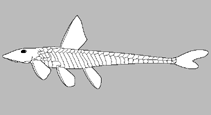Hisonotus leucophrys Carvalho & Reis, 2009
Upload your photos and videos
Google imageNo image available for this species;
drawing shows typical species in Loricariidae.
Google imageNo image available for this species;
drawing shows typical species in Loricariidae.
Classification / Names Κοινά ονόματα | Συνώνυμα | Catalog of Fishes(Γένος, Είδη) | ITIS | CoL | WoRMS | Cloffa
> Siluriformes (Catfishes) > Loricariidae (Armored catfishes) > Hypoptopomatinae
Etymology: Hisonotus: Greek, isos = equal + Greek, noton = back (Ref. 45335); leucophrys: The species epithet leucophrys, from the Greek leucos, white and ophrys, eyebrow, referring to the white longitudinal stripe above eye orbit in the species. A noun in apposition.
More on authors: Carvalho & Reis.
Etymology: Hisonotus: Greek, isos = equal + Greek, noton = back (Ref. 45335); leucophrys: The species epithet leucophrys, from the Greek leucos, white and ophrys, eyebrow, referring to the white longitudinal stripe above eye orbit in the species. A noun in apposition.
More on authors: Carvalho & Reis.
Environment: milieu / climate zone / depth range / distribution range Οικολογία
; Γλυκού νερού βενθοπελαγικό. Tropical; 27°S - 28°S, 51°W - 53°W
Κατανομή Χώρες | Περιοχές FAO | Οικοσυστήματα | Παρουσίες | Point map | Εισαγωγές | Faunafri
South America: Brazil. Known only from two tributaries of the right margin of the upper rio Uruguay, the rio Ariranhas and the rio Rancho Grande (Ref. 80996).
Μέγεθος / Βάρος / Age
Short description Κλείδες προσδιορισμού | Μορφολογία | Μορφομετρία
Ραχιαίες άκανθες (συνολικά) : 2; Μαλακές ραχιαίες ακτίνες (συνολικά) : 7; Εδρικές άκανθες: 1; Μαλακές εδρικές ακτίνες: 5. Hisonotus leucophrys differs from its congeners, except Hisonotus montanus, by having comparatively broader light stripes on dorsolateral surface of head, from snout tip to posterior end of compound pterotic (wider than pupil diameter) vs. narrow light stripes on dorsal surface of head extended from snout tip to posterior end of compound pterotic, or no longitudinal stripes in that region. Hisonotus leucophrys differs from Hisonotus montanus by having the snout covered with odontodes, without an odontode-free band vs. anterior portion of snout with an odontode-free band; and by having an infraorbital canal entering the infraorbital series via the sphenotic vs. infraorbital canal entering the infraorbital series via the compound pterotic (Ref. 80996).
Facultative air-breathing in the genus (Ref. 126274); This species inhabits median to fast flowing watercourses of clear water, with stones and sand on the bottom, and are found in aquatic, partially submersed, vegetation islands composed by grass (Ref. 80996).
Life cycle and mating behavior Γεννητική Ωρίμανση | Αναπαραγωγή | Γεννοβολία | Αβγά | Γονιμότητα | Προνύμφες
Main reference
Upload your references | Αναφορές | Συντονιστής : Fisch-Muller, Sonia | Συνεργάτες
Carvalho, T.P. and R.R. Reis, 2009. Four new species of Hisonotus (Siluriformes: Loricariidae) from the upper rio Uruguay, southeastern South America, with a review of the genus in the rio Uruguay basin. Zootaxa 2113:1-40. (Ref. 80996)
CITES
Not Evaluated
Threat to humans
Harmless
Human uses
FAO - Publication: search | FishSource |
Περισσότερες πληροφορίες
Trophic ecology
Τροφικά αντικείμενα
Σύσταση δίαιτας
Κατανάλωση τροφής
Food rations
Θηρευτές
Τροφικά αντικείμενα
Σύσταση δίαιτας
Κατανάλωση τροφής
Food rations
Θηρευτές
Population dynamics
Παράμετροι Αύξησης
Max. ages / sizes
Length-weight rel.
Length-length rel.
Length-frequencies
Mass conversion
Στρατολόγηση
Αφθονία
Παράμετροι Αύξησης
Max. ages / sizes
Length-weight rel.
Length-length rel.
Length-frequencies
Mass conversion
Στρατολόγηση
Αφθονία
Life cycle
Αναπαραγωγή
Γεννητική Ωρίμανση
Maturity/Gills rel.
Γονιμότητα
Γεννοβολία
Spawning aggregations
Αβγά
Egg development
Προνύμφες
Δυναμική προνυμφών
Αναπαραγωγή
Γεννητική Ωρίμανση
Maturity/Gills rel.
Γονιμότητα
Γεννοβολία
Spawning aggregations
Αβγά
Egg development
Προνύμφες
Δυναμική προνυμφών
Anatomy
Επιφάνεια βραγχίων
Brain
Otolith
Επιφάνεια βραγχίων
Brain
Otolith
Physiology
Body composition
Nutrients
Κατανάλωση οξυγόνου
Κολυμβητικός τύπος
Ταχύτητα κολύμβησης
Visual pigments
Fish sound
Diseases & Parasites
Toxicity (LC50s)
Body composition
Nutrients
Κατανάλωση οξυγόνου
Κολυμβητικός τύπος
Ταχύτητα κολύμβησης
Visual pigments
Fish sound
Diseases & Parasites
Toxicity (LC50s)
Genetics
Γενετική
Heterozygosity
Κληρονομικότητα
Γενετική
Heterozygosity
Κληρονομικότητα
Human related
Aquaculture systems
Προφίλ υδατοκαλλιεργειών
Στελέχοι
Ciguatera cases
Stamps, coins, misc.
Aquaculture systems
Προφίλ υδατοκαλλιεργειών
Στελέχοι
Ciguatera cases
Stamps, coins, misc.
Εργαλεία
E-book | Οδηγός πεδίου | Ανάλυση κατά μήκος συνθέσεων | Εργαλείο ιστορίας ζωής | Σημειακός χάρτης | Classification Tree
| Catch-MSY |
Special reports
Download XML
Διαδικτυακές πηγές
AFORO (otoliths) | Aquatic Commons | BHL | Cloffa | BOLDSystems | Websites from users | Check FishWatcher | CISTI | Catalog of Fishes: Γένος, Είδη | DiscoverLife | ECOTOX | FAO - Publication: search | Faunafri | Fishipedia | Fishtrace | GenBank: genome, nucleotide | GloBI | Google Books | Google Scholar | Google | IGFA World Record | MitoFish | Otolith Atlas of Taiwan Fishes | PubMed | Reef Life Survey | Socotra Atlas | Δέντρο Ζωής | Wikipedia: Go, αναζήτηση | World Records Freshwater Fishing | Zoobank | Zoological Record
Estimates based on models
Phylogenetic diversity index (Ref. 82804): PD50 = 0.5000 [Uniqueness, from 0.5 = low to 2.0 = high].
Bayesian length-weight: a=0.00851 (0.00374 - 0.01935), b=3.09 (2.90 - 3.28), in cm total length, based on LWR estimates for this (Sub)family-body shape (Ref. 93245).
Fishing Vulnerability (Ref. 59153): Low vulnerability (10 of 100).




